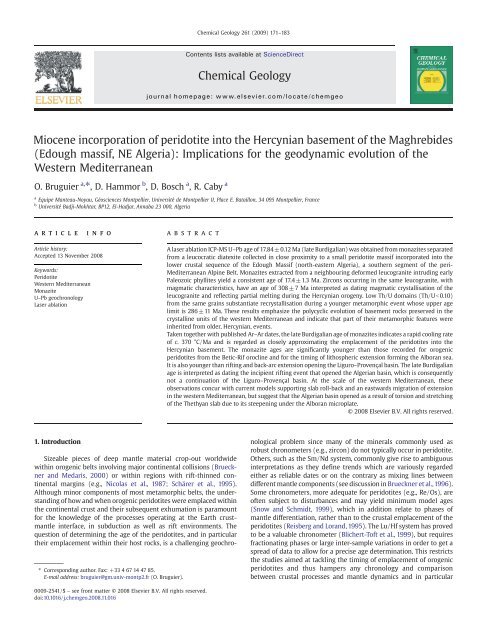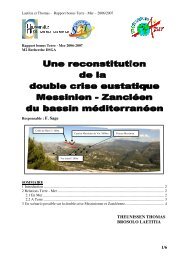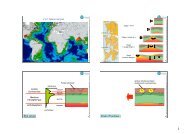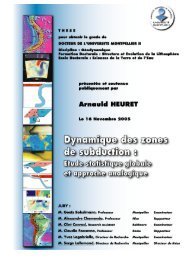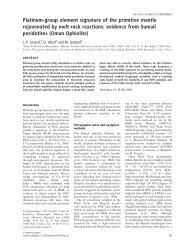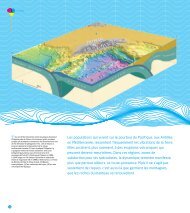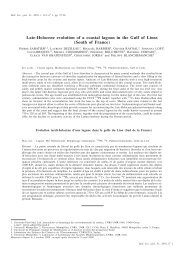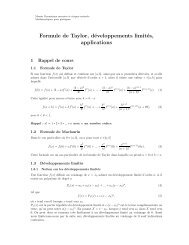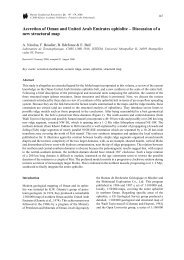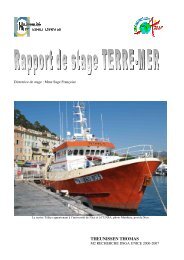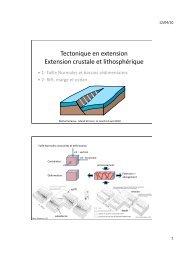Géochronologie U-Pb par ablation laser et ICP-MS (LA-ICP-MS ...
Géochronologie U-Pb par ablation laser et ICP-MS (LA-ICP-MS ...
Géochronologie U-Pb par ablation laser et ICP-MS (LA-ICP-MS ...
You also want an ePaper? Increase the reach of your titles
YUMPU automatically turns print PDFs into web optimized ePapers that Google loves.
Chemical Geology 261 (2009) 171–183<br />
Contents lists available at ScienceDirect<br />
Chemical Geology<br />
journal homepage: www.elsevier.com/locate/chemgeo<br />
Miocene incorporation of peridotite into the Hercynian basement of the Maghrebides<br />
(Edough massif, NE Algeria): Implications for the geodynamic evolution of the<br />
Western Mediterranean<br />
O. Bruguier a, ⁎, D. Hammor b , D. Bosch a , R. Caby a<br />
a Equipe Manteau-Noyau, Géosciences Montpellier, Université de Montpellier II, Place E. Bataillon, 34 095 Montpellier, France<br />
b Université Badji-Mokhtar, BP12, El-Hadjar, Annaba 23 000, Algeria<br />
article<br />
info<br />
abstract<br />
Article history:<br />
Accepted 13 November 2008<br />
Keywords:<br />
Peridotite<br />
Western Mediterranean<br />
Monazite<br />
U–<strong>Pb</strong> geochronology<br />
Laser <strong>ablation</strong><br />
A <strong>laser</strong> <strong>ablation</strong> <strong>ICP</strong>-<strong>MS</strong> U–<strong>Pb</strong> age of 17.84±0.12 Ma (late Burdigalian) was obtained from monazites se<strong>par</strong>ated<br />
from a leucocratic diatexite collected in close proximity to a small peridotite massif incorporated into the<br />
lower crustal sequence of the Edough Massif (north-eastern Algeria), a southern segment of the peri-<br />
Mediterranean Alpine Belt. Monazites extracted from a neighbouring deformed leucogranite intruding early<br />
Paleozoic phyllites yield a consistent age of 17.4±1.3 Ma. Zircons occurring in the same leucogranite, with<br />
magmatic characteristics, have an age of 308±7 Ma interpr<strong>et</strong>ed as dating magmatic crystallisation of the<br />
leucogranite and reflecting <strong>par</strong>tial melting during the Hercynian orogeny. Low Th/U domains (Th/Ub0.10)<br />
from the same grains substantiate recrystallisation during a younger m<strong>et</strong>amorphic event whose upper age<br />
limit is 286±11 Ma. These results emphasize the polycyclic evolution of basement rocks preserved in the<br />
crystalline units of the western Mediterranean and indicate that <strong>par</strong>t of their m<strong>et</strong>amorphic features were<br />
inherited from older, Hercynian, events.<br />
Taken tog<strong>et</strong>her with published Ar–Ar dates, the late Burdigalian age of monazites indicates a rapid cooling rate<br />
of c. 370 °C/Ma and is regarded as closely approximating the emplacement of the peridotites into the<br />
Hercynian basement. The monazite ages are significantly younger than those recorded for orogenic<br />
peridotites from the B<strong>et</strong>ic-Rif orocline and for the timing of lithospheric extension forming the Alboran sea.<br />
It is also younger than rifting and back-arc extension opening the Liguro–Provençal basin. The late Burdigalian<br />
age is interpr<strong>et</strong>ed as dating the incipient rifting event that opened the Algerian basin, which is consequently<br />
not a continuation of the Liguro–Provençal basin. At the scale of the western Mediterranean, these<br />
observations concur with current models supporting slab roll-back and an eastwards migration of extension<br />
in the western Mediterranean, but suggest that the Algerian basin opened as a result of torsion and str<strong>et</strong>ching<br />
of the Th<strong>et</strong>hyan slab due to its steepening under the Alboran microplate.<br />
© 2008 Elsevier B.V. All rights reserved.<br />
1. Introduction<br />
⁎ Corresponding author. Fax: +33 4 67 14 47 85.<br />
E-mail address: bruguier@gm.univ-montp2.fr (O. Bruguier).<br />
Sizeable pieces of deep mantle material crop-out worldwide<br />
within orogenic belts involving major continental collisions (Brueckner<br />
and Medaris, 2000) or within regions with rift-thinned continental<br />
margins (e.g., Nicolas <strong>et</strong> al., 1987; Schärer <strong>et</strong> al., 1995).<br />
Although minor components of most m<strong>et</strong>amorphic belts, the understanding<br />
of how and when orogenic peridotites were emplaced within<br />
the continental crust and their subsequent exhumation is <strong>par</strong>amount<br />
for the knowledge of the processes operating at the Earth crustmantle<br />
interface, in subduction as well as rift environments. The<br />
question of d<strong>et</strong>ermining the age of the peridotites, and in <strong>par</strong>ticular<br />
their emplacement within their host rocks, is a challenging geochronological<br />
problem since many of the minerals commonly used as<br />
robust chronom<strong>et</strong>ers (e.g., zircon) do not typically occur in peridotite.<br />
Others, such as the Sm/Nd system, commonly give rise to ambiguous<br />
interpr<strong>et</strong>ations as they define trends which are variously regarded<br />
either as reliable dates or on the contrary as mixing lines b<strong>et</strong>ween<br />
different mantle components (see discussion in Brueckner <strong>et</strong> al.,1996).<br />
Some chronom<strong>et</strong>ers, more adequate for peridotites (e.g., Re/Os), are<br />
often subject to disturbances and may yield minimum model ages<br />
(Snow and Schmidt, 1999), which in addition relate to phases of<br />
mantle differentiation, rather than to the crustal emplacement of the<br />
peridotites (Reisberg and Lorand, 1995). The Lu/Hf system has proved<br />
to be a valuable chronom<strong>et</strong>er (Blichert-Toft <strong>et</strong> al., 1999), but requires<br />
fractionating phases or large inter-sample variations in order to g<strong>et</strong> a<br />
spread of data to allow for a precise age d<strong>et</strong>ermination. This restricts<br />
the studies aimed at tackling the timing of emplacement of orogenic<br />
peridotites and thus hampers any chronology and com<strong>par</strong>ison<br />
b<strong>et</strong>ween crustal processes and mantle dynamics and in <strong>par</strong>ticular<br />
0009-2541/$ – see front matter © 2008 Elsevier B.V. All rights reserved.<br />
doi:10.1016/j.chemgeo.2008.11.016


